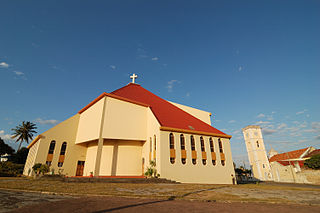
Penedo is a municipality in the state of Alagoas in Brazil. The population is 63,846 in an area of 689.88 square kilometres (266.36 sq mi). Penedo lies 173 kilometres (107 mi) south-west of the state capital of Maceió.
Nossa Senhora da Conceição may refer to:
Nossa Senhora may refer to the following places:

The Roman Catholic Archdiocese of Beira is the Metropolitan See for the ecclesiastical province of Beira in Mozambique.

The Roman Catholic Diocese of Quelimane is a diocese located in the city of Quelimane in the ecclesiastical province of Beira in Mozambique.

The Roman Catholic Archdiocese of Belém do Pará is an archdiocese located in the city of Belém in Brazil. It covers 3,566,079 square kilometres (1,376,871 sq mi) and is organized into 80 parishes. The Archdiocese covers the municipalities of Belém, Ananindeua, Benevides, Marituba, and Santa Bárbara do Pará.

The Cathedral of Our Lady of the Immaculate Conception, commonly known as the Maputo Cathedral is a Roman Catholic cathedral in downtown Maputo, the capital of Mozambique. The cathedral is located on Praça da Independência next to Hotel Rovuma and Maputo City Hall. It is dedicated to Our Lady of the Immaculate Conception. The foundation stone for the construction of the church was laid on June 28, 1936, and is located inside the narthex and inscribed by the Bishop of Mozambique and Cape Verde, D. Rafael Maria da Asunção. Construction on the cathedral was completed in 1944.

The Cathedral of Our Lady of the Immaculate Conception also called Santarém Cathedral formerly known as Church of Our Lady of the Immaculate Conception, is located in the historic centre of Santarém, more precisely in the parish of São Salvador in Portugal.
The Our Lady of Fatima Cathedral or simply Cathedral of Benguela is a religious building of the Catholic Church which is in Benguela, in the African country of Angola and serves as the cathedral of the Diocese of Benguela.

The Our Lady of Conception Church also simply called Church of the Conception, is the name given to a parish church that is affiliated with the Catholic Church and is located in the Água Grande District, specifically on Conceição Avenue right next to the "Hotel Residêncial Baía" in the town of São Tomé on the island of the same name, capital of the African country of São Tomé and Principe.

The Our Lady of Grace Cathedral also called Cathedral of Batafá, is a religious building that is affiliated with the Catholic Church and is located in the town of Bafatá in the region of Batafá one of those that make the African country of Guinea-Bissau. This is one of the two cathedrals that exist in that nation being the other dedicated to Our Lady of the Candles found in the capital, Bissau. The building more than a cathedral is more like a parish church of Portuguese colonial style.

The Our Lady of Grace Cathedral also called Catedral Nossa Senhora de Belém. It is the seat of the Roman Catholic Archdiocese of Belém do Pará and is located in the old quarter of the city in Belém in Brazil. The cathedral is dedicated to Our Lady of Grace, and dates to the earliest settlement of the Portuguese in Belém. The first chapel dedicated to Our Lady of Grace was a temporary structure inside the Presépio Fort; it was moved to a large square in front of the fort. The current structure, the third, was built in the Baroque style, but was later modified with numerous Neoclassical architecture elements by the architect João Landi. The cathedral was listed as a historic structure by the National Historic and Artistic Heritage Institute in 1940.

The Our Lady of the Assumption Cathedral also called Saurimo Cathedral Is the name given to a religious building affiliated with the Catholic Church which is located in the city of Saurimo in the province of Lunda Sul in the northeast of the African country of Angola.

The Our Lady of the Immaculate Conception Cathedral also called Inhambane Cathedral Is the name that receives a religious building affiliated to the Catholic Church that is located in the city of Inhambane In the province of the same name to the south of the African country of Mozambique. The current structure dates from 1974 and replaces the old cathedral of Inhambane that has a strong Portuguese influence and now has the condition of parochial church.

The Our Lady of the Conception Cathedral, also known as Guarulhos Cathedral, is a religious building belonging to the Catholic Church. It was built in the year 1665 in the center of the city of Guarulhos in the South American country of Brazil. The Cathedral of Our Lady of the Conception is the headquarters of the Catholic Diocese of Guarulhos. Its architecture is one of the most beautiful in the state of São Paulo.

The Church of Our Lady of the Rosary is a Catholic church built between 1544 and 1547, in Old Goa, State of Goa, India. This church is part of the collection belonging to the World Heritage Site of churches and convents of Goa.

















